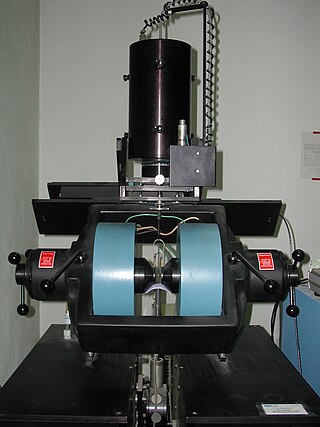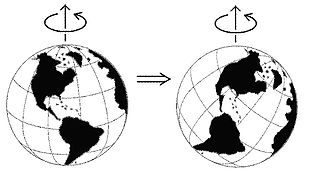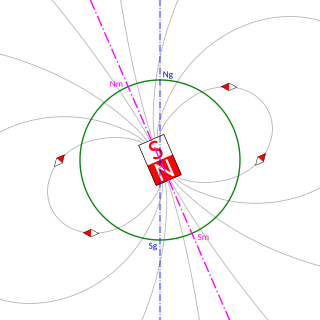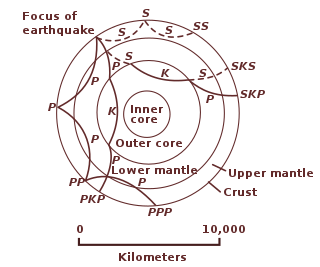Related Research Articles

Plate tectonics is the scientific theory that Earth's lithosphere comprises a number of large tectonic plates which have been slowly moving since about 3.4 billion years ago. The model builds on the concept of continental drift, an idea developed during the first decades of the 20th century. Plate tectonics came to be accepted by geoscientists after seafloor spreading was validated in the mid-to-late 1960s.

Earth's magnetic field, also known as the geomagnetic field, is the magnetic field that extends from Earth's interior out into space, where it interacts with the solar wind, a stream of charged particles emanating from the Sun. The magnetic field is generated by electric currents due to the motion of convection currents of a mixture of molten iron and nickel in Earth's outer core: these convection currents are caused by heat escaping from the core, a natural process called a geodynamo.

Geochronology is the science of determining the age of rocks, fossils, and sediments using signatures inherent in the rocks themselves. Absolute geochronology can be accomplished through radioactive isotopes, whereas relative geochronology is provided by tools such as paleomagnetism and stable isotope ratios. By combining multiple geochronological indicators the precision of the recovered age can be improved.

Paleomagnetism is the study of magnetic fields recorded in rocks, sediment, or archeological materials. Geophysicists who specialize in paleomagnetism are called paleomagnetists.

Rock magnetism is the study of the magnetic properties of rocks, sediments and soils. The field arose out of the need in paleomagnetism to understand how rocks record the Earth's magnetic field. This remanence is carried by minerals, particularly certain strongly magnetic minerals like magnetite. An understanding of remanence helps paleomagnetists to develop methods for measuring the ancient magnetic field and correct for effects like sediment compaction and metamorphism. Rock magnetic methods are used to get a more detailed picture of the source of the distinctive striped pattern in marine magnetic anomalies that provides important information on plate tectonics. They are also used to interpret terrestrial magnetic anomalies in magnetic surveys as well as the strong crustal magnetism on Mars.
Allan Verne Cox was an American geophysicist. His work on dating geomagnetic reversals, with Richard Doell and Brent Dalrymple, made a major contribution to the theory of plate tectonics. Allan Cox won numerous awards, including the prestigious Vetlesen Prize, and was the president of the American Geophysical Union. He was the author of over a hundred scientific papers, and the author or editor of two books on plate tectonics. On January 27, 1987, Cox died in an apparent suicide.
The cataclysmic pole shift hypothesis is a pseudo-scientific claim that there have been recent, geologically rapid shifts in the axis of rotation of Earth, causing calamities such as floods and tectonic events or relatively rapid climate changes.
A geomagnetic reversal is a change in a planet's magnetic field such that the positions of magnetic north and magnetic south are interchanged. The Earth's field has alternated between periods of normal polarity, in which the predominant direction of the field was the same as the present direction, and reverse polarity, in which it was the opposite. These periods are called chrons.

In geophysics, a magnetic anomaly is a local variation in the Earth's magnetic field resulting from variations in the chemistry or magnetism of the rocks. Mapping of variation over an area is valuable in detecting structures obscured by overlying material. The magnetic variation in successive bands of ocean floor parallel with mid-ocean ridges was important evidence for seafloor spreading, a concept central to the theory of plate tectonics.

True polar wander is a solid-body rotation of a planet or moon with respect to its spin axis, causing the geographic locations of the north and south poles to change, or "wander". Unless the body is totally rigid its stable state rotation has the largest moment of inertia axis aligned with the spin axis, with the smaller two moments of inertia axes lying in the plane of the equator. If the body is not in this steady state, true polar wander will occur: the planet or moon will rotate as a rigid body to realign the largest moment of inertia axis with the spin axis.
Polar wander is the motion of a pole in relation to some reference frame. It can be used, for example, to measure the degree to which Earth's magnetic poles have been observed to move relative to the Earth's rotation axis. It is also possible to use continents as reference and observe the relative motion of the magnetic pole relative to the different continents; by doing so, the relative motion of those two continents to each other can be observed over geologic time as paleomagnetism.

The Vine–Matthews–Morley hypothesis, also known as the Morley–Vine–Matthews hypothesis, was the first key scientific test of the seafloor spreading theory of continental drift and plate tectonics. Its key impact was that it allowed the rates of plate motions at mid-ocean ridges to be computed. It states that the Earth's oceanic crust acts as a recorder of reversals in the geomagnetic field direction as seafloor spreading takes place.
Magnetostratigraphy is a geophysical correlation technique used to date sedimentary and volcanic sequences. The method works by collecting oriented samples at measured intervals throughout the section. The samples are analyzed to determine their characteristic remanent magnetization (ChRM), that is, the polarity of Earth's magnetic field at the time a stratum was deposited. This is possible because volcanic flows acquire a thermoremanent magnetization and sediments acquire a depositional remanent magnetization, both of which reflect the direction of the Earth's field at the time of formation. This technique is typically used to date sequences that generally lack fossils or interbedded igneous rock. It is particularly useful in high-resolution correlation of deep marine stratigraphy where it allowed the validation of the Vine–Matthews–Morley hypothesis related to the theory of plate tectonics.
Plate reconstruction is the process of reconstructing the positions of tectonic plates relative to each other or to other reference frames, such as the Earth's magnetic field or groups of hotspots, in the geological past. This helps determine the shape and make-up of ancient supercontinents and provides a basis for paleogeographic reconstructions.

The geomagnetic poles are antipodal points where the axis of a best-fitting dipole intersects the surface of Earth. This theoretical dipole is equivalent to a powerful bar magnet at the center of Earth, and comes closer than any other point dipole model to describing the magnetic field observed at Earth's surface. In contrast, the magnetic poles of the actual Earth are not antipodal; that is, the line on which they lie does not pass through Earth's center.

The following outline is provided as an overview of and topical guide to geophysics:
In geomagnetism, paleointensity is the study of changes in the strength of the geomagnetic field over Earth's history. Émile and Odette Thellier were the first to make laboratory measurements to determine the strength of the ancient field responsible for producing remanent magnetization in a rock or archeological artifacts.

Crustal magnetism is the magnetic field of the crust of a planetary body. The crustal magnetism of Earth has been studied; in particular, various magnetic crustal anomalies have been studied. Two examples of crustal magnetic anomalies on Earth that have been studied in the Americas are the Brunswick magnetic anomaly (BMA) and East Coast magnetic anomaly (ECMA). Also, there can be a correlation between physical geological features and certain readings from crustal magnetism on Earth. Below the surface of the Earth, the crustal magnetism is lost because the temperature rises above the curie temperature of the materials producing the field.
Paleomagnetic poles or paleopoles are positions of the geomagnetic poles identified by the study of magnetic fields of the past as recorded in rocks and sediments.
Richard G. Gordon is an American geophysicist, known for his research on global tectonics, including global plate motions and palaeomagnetism. He is noteworthy for leading two global plate motion projects: NUVEL and MORVEL. In the geosciences, NUVEL and MORVEL are standard models for global plate motions.
References
- ↑ Kearey, Philip; Klepeis, Keith A.; Vine, Frederick J. (2009). Global Tectonics (3 ed.). Chichester: Wiley. p. 67. ISBN 978-1-4051-0777-8.
- 1 2 3 4 5 6 Tauxe, Lisa (2010). Essentials of Paleomagnetism. University of California. ISBN 9780520260313.
{{cite book}}: CS1 maint: location missing publisher (link) - 1 2 3 4 5 6 7 McElhinny, M.; McFadden, P. (2000). Paleomagnetism: Continents and Oceans. Academic Press. ISBN 978-0080513461.
- ↑ Wu, L.; Kravchinsky V.A. (2014). "Derivation of paleo-longitude from the geometric parametrization of apparent polar wander path: implication for absolute plate motion reconstruction". Geophysical Research Letters. 41 (13): 4503–4511. Bibcode:2014GeoRL..41.4503W. doi:10.1002/2014GL060080.